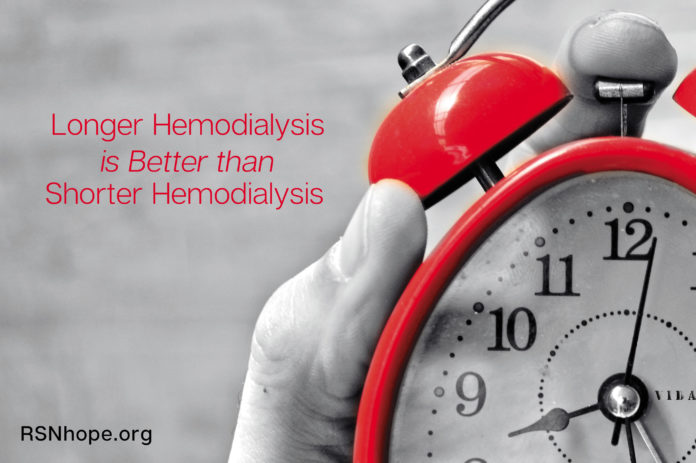When chronic hemodialysis (HD) treatments were introduced in the early 1960s, they were long procedures, requiring 20-40 hours per week when performed in-center, or 8-10 hours three times per week when performed at home. The dialyzers being used were not very efficient (low-efficiency dialyzers), but people tolerated the procedure well. Blood pressure (BP) medications were not needed by the vast majority of patients.
The tendency to shorten dialysis treatment time continued in the 1970s. The major incentive was the need for more efficient utilization of dialysis centers because the number of candidates for chronic dialysis markedly exceeded the availability of treatment facilities. Shorter dialysis treatments also saved money, as more patients could be treated in the same facility utilizing more shifts.In the late 1970s, an increasing number of renal care centers in Europe and the U.S. followed this trend. The push to shorten dialysis was particularly strong in the U.S. This trend was less prominent in Japan, where duration of dialysis is still longer than in Europe and the U.S.
In the late 1970s and early 1980s, short dialysis received support from a new measure of dialysis adequacy based on urea kinetics. The National Institutes of Health sponsored the National Cooperative Dialysis Study to establish objective, quantitative criteria for the adequate dose of dialysis. It was widely accepted that the dialysis dose should be measured using Kt/Vurea: the amount of urea clearance (Kurea) multiplied by time (t) and divided by total body water (V). Frequency of hospitalizations was used to judge the quality of dialysis being delivered.The study suggested that time on dialysis is of minor importance as long as Kt/Vurea equals 0.95-1.0. This number was later increased to 1.3, but the assumption that HD time is of relatively minimal importance remained unchanged.This Kt/V index, much popularized in the dialysis community, became the yardstick for measuring dialysis adequacy. Short dialysis had tremendous appeal to the patients once they were told that the outcomes were equivalent (or better!) to those achieved with long dialysis.
“Why should I stay on dialysis for a long time if I don’t really have to?” a patient might ask.
Body Water Pools
However, there are many facts indicating that the length of the dialysis treatment is important, and for many reasons. In order to achieve a good Kt/Vurea with short dialysis, maximization of dialysis efficiency–by using high efficiency dialyzers and high blood and dialysate flows–is required (and high flow rates are not necessarily a good thing).
Let me explain it in this way: It is important to realize that the water in your body is distributed into at least three compartments. This may be compared to the multiple swimming pool system in a large complex. Let’s imagine that the complex is composed of three pools–large, middle-sized, and little ones.
- The large pool represents the intracellular water (the water found in each of your body’s cells).
- The middle pool represents the interstitial water (the water found in your organs and tissues.
- The small pool represents your blood.
Now, let’s imagine that these three pools are connected by small pipes. The movement of water between the pools is controlled by gravity: the greater the difference in the amount of water contained in the pools, the more the water will flow from one pool into the other. In other words, the water will flow from a pool that is filled to one that isn’t.
Finally, let’s imagine that the water from the small pool (your blood) is being removed very rapidly. Because of the small pipe size, the water from the middle pool (your organs and tissues) cannot refill the amount of water in the small pool (your blood) quickly enough, so the volume of water in your blood rapidly decreases until it falls below a critical level.
Crashing on Dialysis
This is precisely the situation that occurs during a short, highly efficient hemodialysis session. Salt and water are the most important constituents that are being removed quickly from the blood, but they are being replaced slowly from the other compartments (pools). This rapid removal of salt and water causes a rapid decrease in blood volume and leads to hypotension (low BP) during dialysis.
In mild cases, patients feel weak and suffer from muscle cramps, but in cases where the depletion of salt and water is severe and the BP is very low, the patient “crashes” (and can actually lose consciousness. In those case, it is necessary to infuse saline to quickly fill the blood compartment (elevate the water level in the little pool). There is still excess salt and water in the other compartments (pools), but it takes several hours after completion of the dialysis treatment for the excess salt and water to travel from one compartment to the other so that the levels are the same in all of the pools. In other words, the amount of water in your blood after dialysis is low, and it takes some time for it to increase again.
“Post-Dialysis Hangover”
Immediately after dialysis, this low blood volume causes severe thirst, weakness, and other symptoms similar to those following the heavy use of alcohol (such as weakness, nausea, dizziness, lethargy, anxiety, and headache). This is often referred to as the “post-dialysis hangover.”
For many patients, the first stop after dialysis is at the water fountain to replenish decreased blood volume (filling the little pool as quickly as possible)! The problem is that if you drink too much before your next dialysis, and if the time you spend of dialysis time remains the same, the higher the ultrafiltration (UF) rate must be set must in order to removed that excess water more rapidly. In those cases, the volume depletion in the blood compartment is more severe at the end of dialysis, and the crashes are worse.
Eliminate the Last Hour of Dialysis?
Sometimes, patients ask to stop dialysis early. They want to eliminate this last hour of treatment. But if the dialysis time is cut, the situation (the rapid removal of water and crashing) will be much worse during the next treatment.
The last hour of dialysis is better tolerated if the dialysis time is longer and fluid is removed slowly. In such an event, the removal of water from the small pool (the blood) is slower, so the refill from the middle pool (the tissues) is sufficient to prevent severe volume depletion, and the middle pool has a chance to be refilled from the large pool (the water within the cells) during the dialysis treatment.
Consequently, you will feel well during and immediately after dialysis without crashes or a hangover. Spending less time hooked up to a dialysis machine does not benefit the patient if he/she feels poorly for several hours after the treatment and needs this time to “equilibrate” (refill the pools) and regain strength.
Urine Output
Patients who do not make any urine are particularly prone to problems during short dialysis. Healthy kidneys work 24 hours a day, 168 hours a week. Urine output in healthy persons is about 1.5 liters, or three quarts, per day, for a total of 10.5 liters per week. If a patient does not make any urine, then this amount of fluid must be removed by UF during the HD sessions. If the total time of dialysis per week is only 10.5 hours (based on only three sessions per week), then the fluid must be removed at the rate of 1 liter per hour, which is fast!
Only a few patients can tolerate such rapid fluid removal. Older patients are even less tolerant to high UF rates.
Hypotensive Episodes
Intradialytic hypotension (IDH, low BP occurring during dialysis) occurs in 25%-50% of patients on short, thrice-weekly HD treatments in the U.S. This is much more frequent than in Europe or Japan where dialysis treatments are longer.
In a few centers worldwide, where very long dialysis (eight hours per session) is practiced, hypotensive episodes are extremely rare, and there are no crashes! The detrimental effect of IDH is being increasingly recognized as an important factor in the increased relative risk of death due to heart problems.
Mortality Rates and Treatment Times
A recent study showed that mortality rates are lower with longer treatment time. Every 30 minutes longer that someone spent on HD was associated with a 7% reduction in the risk of death. This was true in the U.S., Europe, and Japan. The study also showed that a high UF rate (over 10 ml/hr/kg) was associated with a 9% increased risk of death. This is another illustration of the same fact: Shorter dialysis requires a high UF rate (rapid fluid removal), which is not a good thing.
This report is not surprising. Similar observations have been made in the past. The annual mortality rate in U.S. dialysis patients has increased over the last three decades, the period during which dialysis time was shortened. By contrast, over this same period, the mortality rate has remained low and stable in Japan, where the dialysis treatment time is about 40% longer.
Controlling High BP
Hypertension (high BP) occurs in about 90% of patients starting HD and persists in 70%-90% of such patients in the U.S., who require BP medications. This is contrary to the situation in the late 1960s, when long dialysis was practiced and the majority of patients did not require such medications.
There is a consensus that most patients on dialysis have so-called “volume-dependent hypertension,” meaning that the body (all pools) contains too much salt and water. The problem is how to achieve normal volumes of salt and water (“dry body weight”) and control BP without medications.
Hypertension in dialysis patients is less frequent in Europe and Japan where dialysis time is longer. The lowest mortality rates in the world related to heart problems are reported from the Centre de rein artificial, in Tassin, France, where long-duration hemodialysis (eight hours three times weekly) is practiced under the leadership of the medical director, Bernard Charra, MD. As would be expected, the long-term mortality rate in this center is lower in patients with lower BPs.
Gentle UF and “Dry Body Weight”
In addition, slow, gentle UF and proper estimation of “dry body weight” allows good BP control in the majority of patients. Hypotension in patients dialyzed three times a week for eight hours per treatment is a strong indicator that the patient’s weight dropped below the true “dry body weight.”
With rapid the UF of short dialysis, hypotension is mostly the result of low blood volume, which occurs long before the optimal “dry body weight” is achieved. It is extremely difficult to estimate true dry body weight with short dialysis. This is one of the reasons that the term “dry body weight,” used in the 1960s and still used in Tassin, has been replaced with the term “target weight.” This is the weight the patient should have after dialysis, regardless of whether or not it is the true “dry body weight.”
Blood Pressure Control Without Meds
With long-duration HD sessions, BP could be controlled without medications in 90%-95% of patients. These would be the patients who have “volume-dependent” hypertension. Only 5%-10% of patients have “refractory” hypertension, which requires blood pressure medications.
The originator of chronic dialysis, Belding H. Scribner, MD, who practiced long-duration dialysis sessions in the 1960s, advocated forcefully for departure from short dialysis and for more attention to volume management in order to achieve BP control.
Disadvantages of Short Dialysis
There are other disadvantages to short, high-efficiency dialysis related to the problem of insufficient removal of toxins, which move slowly between the compartments. Inadequate removal of these toxins is responsible for many symptoms, including:
- Poor appetite;
- Bad or altered sense of taste;
- Nausea and vomiting;
- Restless leg syndrome;
- Burning feet syndrome;
- Insomnia;
- Depression;
- Itching; and
- Sleep apnea.
Although many of these symptoms may have other causes, their presence, particularly in combination, is suggestive of inadequate dialysis.
Conclusion
Short dialysis is associated with poor tolerance of fluid removal (UF); frequent intradialytic hypotensive episodes, cramps, and crashes during dialysis; poor control of blood pressure; and a high mortality rate. Patients themselves should watch for symptoms related to rapid UF. If symptoms are present, the patients should ask for longer dialysis, and the UF rate should be reduced accordingly.
Even one hour longer on dialysis will bring remarkable improvement within only a few weeks! The longer dialysis duration is particularly beneficial in patients who do not make any urine.
 About the Author
About the Author
Zbylut J. Twardowski, MD, PhD, Professor Emeritus of Medicine, University of Missouri, Columbia, is a co-inventor of the buttonhole cannulation technique. He holds 22 patents for dialysis-related inventions and is a recipient of the American Kidney Fund’s prestigious Torchbearer Award and the International Society for Hemodialysis’ Trailblazer Award.
Web ID 330







